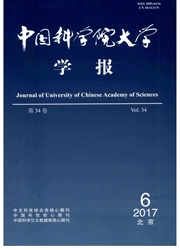

 中文摘要:
中文摘要:
超嗜热菌Aquifex aeolicus亮氨酰-tRNA合成酶(αβ-LeuRS)是已知的唯一的双肽链LeuRS.通过αβ-LeuRS和大肠杆菌LeuRS相应肽段的重组和重组酶性质的研究发现,αβ-LeuRS的α亚基C末端36个氨基酸对于αβ-LeuRS的氨基酰化活力至关重要.αβ-LeuRS的两个亚基人为融合得到的单亚基酶SLeuRS-αβ,具有完全的野生型双亚基酶活力,其热稳定性显著增强.同时,通过亚基重组揭示了LeuRS对于不同种属的tRNA^Leu的识别元件位于α亚基内,而其中的CP1结构域不仅是LeuRS行使编校功能的结构基础,对于LeuRS识别不同种属来源的tRNA^Leu也是十分重要的.通过不同来源的LeuRS一级结构比较,克隆了单独的CP1结构域组成的肽(CP1),发现唯有A.aeolicus αβ-LeuRS的CP1对错误的氨基酰化产物具有体外编校功能.它与其他3种来源于细菌LeuRS的CP1都能够编校误氨基酰化的古老形式的亮氨酸小螺旋(minihelix^Leu).通过同源序列比较发现,在αβ-LeuRS的CP1内存在一个由20个氨基酸组成的特异的结构模体,它对CP1发挥体外编校功能必不可少,引入原本不具有体外编校功能的E.coli的CP1后则可使其获得编校功能,但是该模体不影响全酶的编校功能.αβ-LeuRS中与tRNA结合有关的亚基叫亚基也可以赋予E.coliCPl编校功能.这些研究结果充分表明,来源于古老的超嗜热菌A.aeolicus的αβ-LeuRS保留了进化的遗迹——具有编校活力的CP1和与其编校功能密切相关的由20个氨基酸组成的特异的结构模体,它们在进化过程中随着其他结构域招募进合成酶中而逐渐失去了对全酶编校功能的作用.这一发现有力地支持了aaRS通过纳入新的结构域以加速进化过程的理论,并且也从不同角度为aaRS/tRNA共进化理论提供了可靠的依据.
 英文摘要:
英文摘要:
Aminoacyl-tRNA synthetases ( aaRSs ) catalyzes specific attachment of amino acids to their the genetic code in the first step of the protein comprise an ancient, diverse enzyme family that cognate tRNAs and ensures the accurate translation of synthesis . On the basis of conserved sequence and characteristic structural motifs, aaRSs can be divided into two classes (class Ⅰ and Ⅱ ) with ten members in each class. Leucyl-tRNA synthetase (LeuRS) belongs to class Ia aaRSs and the canonical LeuRSs are monomer. Aquifex aeolicus αβ-LeuRS is the only known heterodimeric LeuRS. By fusion and recombination of the genes encoding the α and β subunits from A. aeolicus αβ-LeuRS and the equivalent amino-and carboxy-terminal parts of E. coli LeuRS (identified as α' and β'), five monomeric and five heterodimeric LeuRS mutants were obtained. Seven of these were successfully overexpressed in vivo and purified, while three dimeric mutants with the β' part of E. coli LeuRS were not successfully expressed. The seven purified mutants catalyzed amino acid activation, although several exhibited reduced aminoacylation properties. Removal of the last 36 residues of the α subunit of the A. aeolicus enzyme was determined to be deleterious for tRNA charging. The subunit exchange showed that the cross-species- specific recognition of A. aeolicus tRNA^Lcu occurs at the a subunit. None of the mixed E. coli-A. aeolicus enzymes were as thermostable as the native αβ-LeuRS. However, the fusion of the α and β peptides from A. aeolicus as a single chain analogous to canonical LeuRS resulted in a product more resistant to heat denaturation than the original enzyme. The editing reactions catalyzed by aaRSs are critical for the faithful protein synthesis by correcting errors. We reported that only the isolated editing domain (CP1 domain) of αβ-LeuRS catalyzes the hydrolytic editing of both mischarged tRNA^Leu and minihelix^Leu . Within the domain, we identified a crucial 20-amino-acid motif to the editing of
 同期刊论文项目
同期刊论文项目
 同项目期刊论文
同项目期刊论文
 Two distinct domains of the ( subunit of Aquifex aeolicus leucyl-tRNA synthetase are involved in tRN
Two distinct domains of the ( subunit of Aquifex aeolicus leucyl-tRNA synthetase are involved in tRN Tertiary-structure base pairs between D- and T(C- loops of Escherichia coli tRNALeu play important r
Tertiary-structure base pairs between D- and T(C- loops of Escherichia coli tRNALeu play important r 期刊信息
期刊信息
